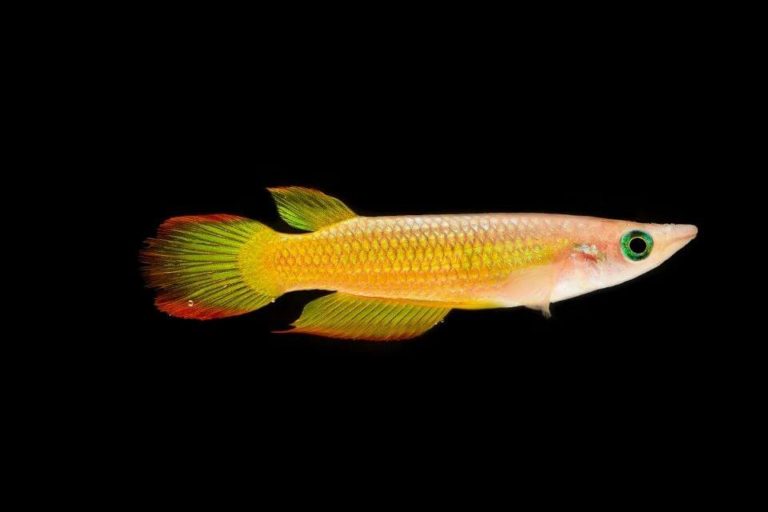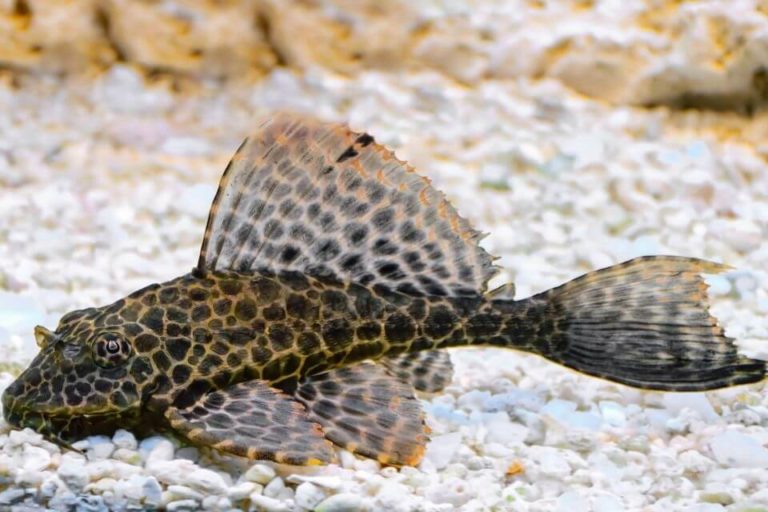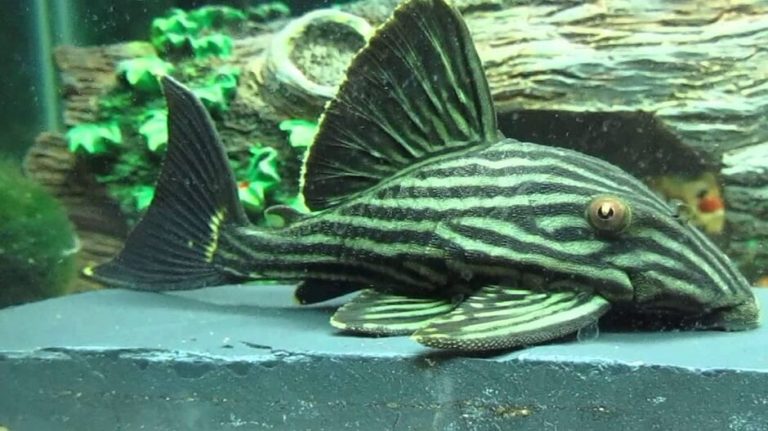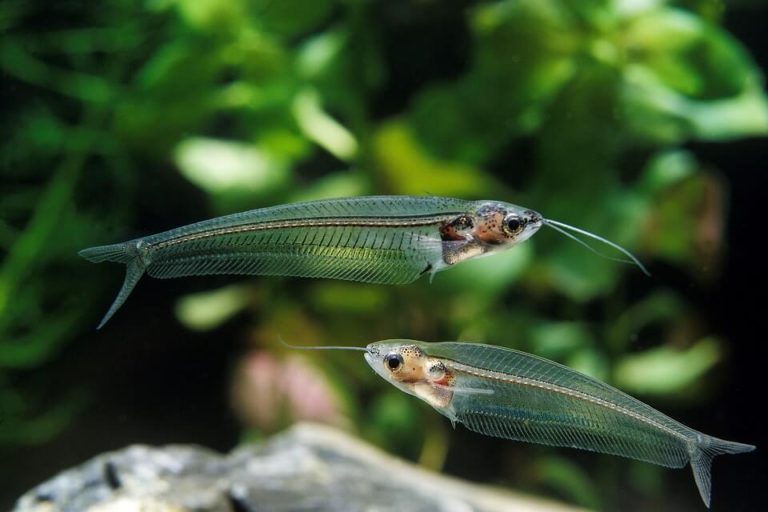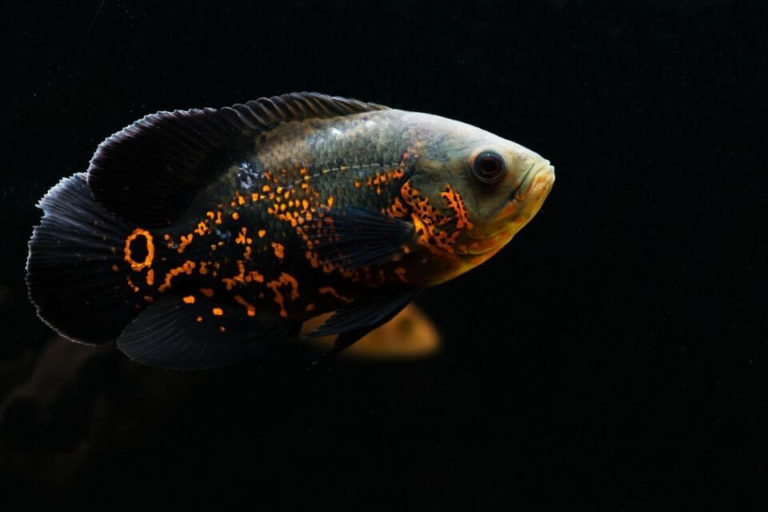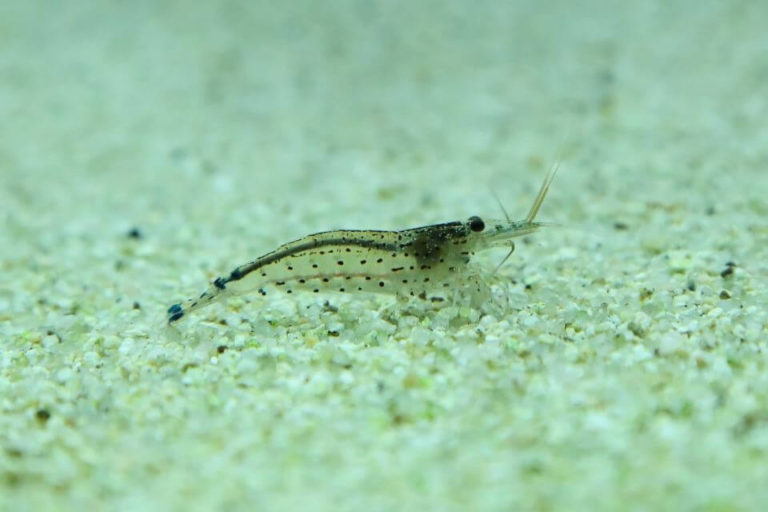Wolf Cichlid Care Guide – Habitat Setup, Tank Mates, Diet and Breeding
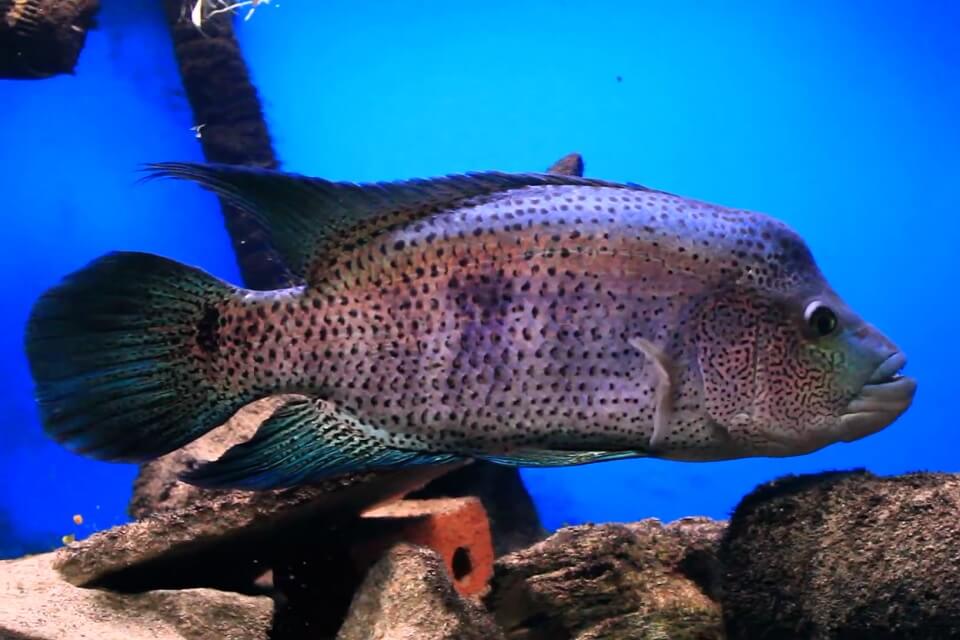
If you are planning on having Wolf Cichlid as a pet for the first time, you will need good knowledge about caring for them because they are very aggressive Cichlid Species.
To maintain their aggressive nature you will need a significantly large tank in order to keep them. This fish is relatively big, with adults growing up to 24 to 28 inches (60 to 71 centimeters) in length.
Understanding their behavior along with other vital aspects like how to take care of them is essential for their survival in your aquarium.
The Wolf Cichlid is an attractive and menacing specimen of Cichlid. Also referred to as Parachromis dovii, this fish can be a bit challenging to take care of, especially for newbie aquarists.
Therefore, to better understand how to take care of these fish species as a novice aquarist. Consider reading this article to the end as we take you through the Wolf Cichlid care guide and species profile.
| Quick Facts: | |
|---|---|
| Common Names : | Wolf Cichlid |
| Origin : | Freshwater bodies of Central America |
| Family : | Cichlidae |
| Scientific Name : | Parachromis dovii |
| Care Level : | Difficult |
| Temperament : | Very Aggressive |
| Social : | Territorial |
| Diet : | Carnivores |
| Size (average) : | Up to 28 inches |
| Lifespan : | Up to 30 years |
| Breeding : | Egg layer |
| Minimum Tank Size: | 150 gallons |
| Tank Environment : | Freshwater Sandy substrate Driftwood, Rocks Artificial plastic plants |
| Temperature : | 70 – 99 °F (21 – 37 °C) |
| Water Hardness : | 5 - 12 dGH |
| Water pH Level : | 6.0 - 8.0 |
Species Overview
The Wolf Cichlid is a significantly large and deep-bodied freshwater fish species with big teeth and a large mouth showing a vicious predator. The fish is packed with solid muscle, which makes it very aggressive, and it will always attack anything that comes in its path.
Although the fish feature some attractive color patterns, that should not deceive you as they are known to be hyper-aggressive, and they have both attitude and size that backs up their aggression.
And when kept in a home aquarium, Wolf Cichlid will most probably dominate it, and there are relatively few fish species that are compatible living within the same aquarium.
Therefore, as a beginner or an experienced aquarist, you should definitely not keep Wolf Cichlid in one aquarium with conspecifics such as Jaguar Cichlid since they are intolerant of other Cichlid species.
Wolf Cichlid Behavior & Temperament
As stated earlier, this Chchlid breed is hyper-aggressive when it comes to temperament. They are equipped with significantly large mouths and teeth which makes them excellent killing machines.
Additionally, these fishes have very strong muscles that back up their temperament. Since they are carnivorous, Wolf Cichlid will attack small fishes for food.
When it comes to swimming, they are active swimmers and love playing around. And in addition to their hyper-aggressive temperament, Wolf Cichlid are very intelligent, making them behave as if they are trained fishes.
Wolf Cichlid will study other fishes, and whenever they find out that they are peaceful fish, they will attack them for food.
Since they are active swimmers, the Wolf Cichlid tends to jump out of the water; therefore, it is recommended that you secure your aquarium by covering it with a reliable lid.
This is vital to note since there are various reported cases of the fish trying to escape and breaking the tank’s lid. It would be best if you were watchful while feeding them as they can smash the tank’s glass, splashing the whole place.
Origin and Distribution
The Wolf Cichlid’s natural habitat is rivers and lakes and is commonly found in Central America from Honduras to Costa Rica as well as the Atlantic side of Central America. It is believed that the highest population of Wolf Cichlid is in Florida.
Gunther first described these fishes in 1864, and they hate fast-flowing waters. As a result, their largest population can be found more in lakes than rivers. However, they are also known to adapt to slow currents.
They love to dig caverns in their natural environment and like living in lower to middle valley areas. They primarily feed on other fishes but also indulge in insects and crustaceans. In size, the Wolf Cichlid resembles bass fish.
Wolf Cichlid Size
When it comes to Wolf Cichlid size, these fish are known to have decent size. The male Wolf Cichlid are said to grow up to 28 inches in length while females grow up to 16 inches.
Their incredible size couples with their hyper-temperament, making them stand out from other Cichlid as the most aggressive fish. Their size allows them to dominate any aquarium with the utmost ease.
Wolf Cichlid Lifespan
A Wolf Cichlid has an incredible lifespan of over 30 years when taken good care of. Therefore, if you are planning on owning one, you should expect to live with it for an extended period of time with proper care.
Appearance, Colors, And Special Markings
Despite being very aggressive, the Wolf Cichlid has some distinct and attractive colors. A mature male Wolf Cichlid often has a rich golden yellow to a silver background with a spackle of black, blue, and purple.
On the other hand, the female Wolf Cichlid is primarily yellow in color.
Additionally, both genders have red and green on their head as well as on their dorsal fin. They also incorporate a green and blue tail and fin. Wolf Cichlid is also known to have significantly large eyes with bronze iris.
Juveniles present silver coloring on their body with a horizontal black stripe that runs across their body. As the juveniles grow, their black horizontal stripe grows thicker as their body color starts turning to the standard golden yellow portrayed in adults.
There are various color morphs available along with the normal one. Some Wolf Cichlid have orange-red colors and are commonly found in Rio Puerto Viejo and Nicaragua.
Wolf Cichlid Care
Now that you have understood the nature and appearance of Wolf Cichlid, it is time to go through their care. So, to take care of your Wolf Cichlid, you will need to adhere to the following tips;
– Wolf Cichlid Tank Size
The tank required to host a Wolf Cichlid has to be significantly large. You will require a 150 gallons aquarium to host a female Wolf Cichlid who has just reached maturity.
On the other hand, you will require a 200 gallons aquarium to host a male Wolf Cichlid at his maturity age. However, you should expect to upgrade for an adult or fully grown specimen for a larger fish tank of approximately 300 gallons.
Tank size is highly essential when it comes to Wolf Cichlids since they require good water movement as well as significantly robust and efficient friction.
Therefore, you need to meet these tank size requirements in order to have a Wolf Cichlid as a pet.
– Tank Setup
Tank setup is equally important as tank size. From substrate to decorations, lighting, and filtration, you will need to set up your aquarium to best suit your Wolf Cichlid’s needs.
When it comes to a substrate, it is recommended to use sand. This is because Wolf Cichlids love digging substrates. Adding plants will not work since this fish will uproot or destroy them within no time.
As a result, when it comes to decorating your tank, you should consider using rocks and roots as opposed to plants. These decorations should be used as hiding places as well as territory markers by the Wolf Cichlid.
And since these fishes love to dig, you should avoid placing your rocks loosely; you will need to glue them in place and in a pattern that will stop them from topping over.
When it comes to lighting, you will need to use either LED or fluorescent lights. However, LED is the most preferable since it does not add unwanted heat to your aquarium.
Lighting needs should be between moderate and normal; however, some individuals prefer using intense lighting to enhance the fish’s stunning colors.

Wolf Cichlids are known to produce lots of waste, more than an average freshwater tropical fish. As a result, a high-quality and robust filtration system is needed to ensure your fish lives in good water condition.
It has to be 10 to 15 times tank volume per hour. For instance, a 55 gallons aquarium needs a 550 GPH (gallons per hour) filter. A canister filtration system is often the best choice.
– Water Parameters
In the wild, Wolf Cichlids are found in waters that are 70 to 99 degrees Fahrenheit (21 to 37 °C). However, it is not recommended to keep your Wolf Cichlids in these extremes.
Therefore, you should keep them in water temperature within 75 to 82 degrees Fahrenheit (24 to 28 C). Additionally, their water acidity levels have to be within 6.0 to 8.0 pH and a hardness range of 5 to 20 dGH.
Their water current also has to be moderate since they are known to dislike fast-moving waters. To maintain a suitable living environment, you will need to change 10% of your aquarium’s water each week.
– Suitable Plants
Unfortunately, there are no suitable plants for use in an aquarium with a Wolf Cichlid. This is because of their temperament and their behavior for uprooting and destroying plants.
Artificial plastic plants might be a good option if you like your tank to make a stunning look from the outside. But you might need to attach those artificial plants on hard rocks of the tank bottom that might prevent uprooting them.
In fact, it is due to this behavior that you are recommended to glue any décor used in an aquarium with a Wolf Cichlid. However, you might consider using driftwoods, roots, or branches, and like any other décor, they have to be glued to the tank.
At the same time, you will need to look for tank decorations that will injure your fish.
Common Possible Diseases
Like any other freshwater fish species, the Wolf Cichlid is predisposed to various diseases. Therefore, you will need to pay close attention to some of these diseases and keep a close eye on your fish to see if it displays multiple symptoms.
Whenever you spot an unusual behavior in your fish, you will need to take action and follow some simple procedures.
One of the common diseases among Wolf Cichlid is Ich. To find out if your fish suffers from Ich, it will start scratching itself on objects and the gravel.
Treating this condition is relatively easy; all that is required of you is to increase the tank’s temperature to about 30 degrees Celsius or 86 degrees Fahrenheit for three days. You might as well use a copper-based medication to treat it.
In addition to Ich, these fishes are prone to hole in the head disease. This disease looks like a hole or cavity in the head and is commonly known as Head and Lateral Line Erosion or HLLE.
This condition is caused by poor water conditions as well as a lack of proper nutrition. You will need to improve your water condition and nutrition to treat your fish.
Wolf Cichlid Diet & Feeding
They are carnivorous, which means that they feed primarily on meaty foods. In the wild, their diet consists of relatively small fishes, insects, earthworms, small invertebrates as well as crustaceans.
They also accept an array of commercial foods designed for freshwater carnivores.
A Wolf Cichlid has to be fed on ample stick food or pellets as their primary diet. You can supplement it with worms, crickets or prawns, and similar items to significantly vary their diet.
You will need to start by giving an amount of food that they can consume within a minute or so at most once or twice per day. To adjust their feeding and frequency, you will need to monitor their growth rate as well as girth.
Gender Difference
Unlike most fishes out there, differentiating between a male and a female Wolf Cichlid is relatively easy. A male Wolf Cichlid is fairly big, while a female is small and primarily yellow.
Wolf Cichlid Breeding
Wolf Cichlid has been bred while in captivity. They are substrate spawners, and their young ones will be taken good care of by both parents.
To increase their chances of forming mated pairs, you will need to house about 6 to 8 juveniles within the same environment and let them pair together naturally.
However, you should note that a male Wolf Cichlid will excessively beat a female most of the time. In such a situation, you will need a divider equipped with a bottom open that is large enough to allow all eggs to be fertilized.
Usually, a female Wolf Cichlid lays over 1,000 eggs, and they hatch in five days. Their young ones can be fed baby brine along with other meaty foods. Increase their food size as they grow. As they grow, you will need to sort the young ones by size.
This is vital since the bigger siblings can feast on the smaller ones. After 10 to 14 months, a Wolf Cichlid is said to be sexually matured, and they will spawn after every four weeks.
It is neither easy nor difficult to breed a Wolf Cichlid meaning that their ease of breeding is moderate.
Wolf Cichlid Tank Mates
These Cichlid species are without a doubt very aggressive, and a dominant male can quickly kill other Wolf Cichlid when kept in the same tank.
This means that when choosing a tank mate for a Wolf Cichlid, you will need to look for a fish with the same behavior.
Male Wolf Cichlid will coexist with a female Wolf Cichlid in the same tank. In addition to that, the best tank mates include Jaguar Cichlid and other large, aggressive fishes. However, you will need to monitor them significantly.
How Fast Do Wolf Cichlids Grow?
These fish species are known to grow very fast at around 1 inch per month until they are rich at around 12 inches. Once their size reached 12 inches then it slows down their growth rate.
Are Wolf Cichlids Aggressive?
Yes, Wolf Cichlids are very aggressive and highly predatory. It is due to their temperament that it is advisable to keep them with equally sizeable freshwater fish species.
Do Wolf Cichlids Have Teeth?
Since they are carnivorous, Wolf Cichlids have significantly large teeth, making them an excellent voracious predator.
Are Wolf Cichlids Good for Beginners?
Although most experienced aquarists find it relatively easy to take care of Wolf Cichlids. But these fish species are not an excellent choice for newbie aquarists out there.
These fishes are reasonably significant long and need a large aquarium to take good care of them. This might be something that can be challenging for most newbie fishkeepers.
Adding to that is their temperament and aggressiveness, which makes them the least beginner-friendly Cichlid species out there such as Convict Cichlid and Peacock Cichlid.
Where Wolf Cichlid for Sale?
Since these fishes are bred in captivity, it is relatively easy to find one Wolf Cichlid for sale. You can find Wolf Cichlid for sale in a pet fish shop or aquarium center in your hometown.
Additionally, you can purchase online from various eCommerce sites that are trustworthy such as eBay.
Now You Can Decide Without Any Doubt
Wolf Cichlids are significantly large and gorgeous freshwater fish species; however, they are not an excellent choice for novices out there.
This fish is known to be very aggressive and will need good experience as an aquarist to take care of them. Sometimes they can attack you as you maintain your aquarium or even when feeding them.
As an experienced Cichlid enthusiast, the Wolf Cichlid will be best for you. However, you will need to create ample room for them and spend lots of money on them since they require more dedication than most fish.
They will need to be fed some expensive meaty food and be housed in a large aquarium which can be very expensive. As we conclude, we hope you have found this Wolf Cichlid care guide beneficial.


